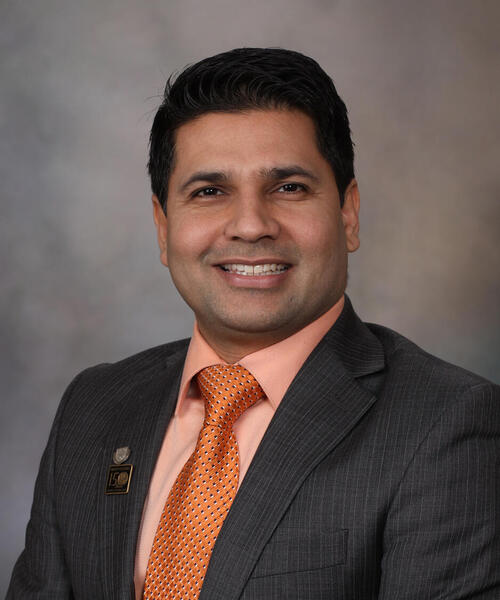Hills and Valleys is a podcast that uncovers stories from leaders in healthcare, tech, and everything in between. Straight from the heart of Silicon Valley, we give you a look at the good, the bad, and the future, one episode at a time. Brought to you by Potrero Medical.
Listen to the podcast on any of the platforms below, watch the full video interview, or continue reading this blog to see the transcript.
About Dr. Rahul Kashyap, Mayo Clinic
Dr . Rahul Kashyap is a clinical research scientist and associate professor at the Mayo Clinic in Rochestoer, Minnesota.
Research has been an integral part of the interests of Rahul Kashyap, MD, since he graduated from medical school in 2005. This interest has grown since he joined the Mayo Clinic in 2006, and revolves around the primary goal of “doing the greatest good for the greatest number of people in a timely fashion.”

The primary areas of focus for Dr. Kashyap include:
- Severe sepsis and septic shock
- Acute lung injury
- Medical informatics in emergency medicine and critical care
- Transfusion-related acute lung injury (TRALI)
- Acute kidney injury
- Cerebrovascular disease (stroke and transient ischemic attack)
- Community-engaged research
- Disaster management
Day-to-day research for Dr. Kashyap includes meaningful use of medical informatics tools with the sole purpose of finding ways to improve health care delivery for patients with severe illnesses in need of emergent care. Besides studying patients, Dr. Kashyap studies health care providers as well as the systems used for the above.
Research done by Dr. Kashyap in severe sepsis and acute lung injury is shining some light on ways to improve early goal-directed therapy (EGDT) and acute lung injury resolution.
Dr. Kashyap has contributed to nearly 100 publications featured in a variety of scientific and academic journals. Some of his professional highlights include:
- Scientific Reviewer, American Medical Informatics Association (AMIA), 2012-present
- Scientific Reviewer and Adviser, International Journal of Medical Students (IJMS), 2011-present
- Best Resident Research Abstract Award, Canadian Association of Emergency Physicians Annual Conference, 2008
An interview with Clinical Research Scientist at Mayo Clinic, Rahul Kashyap
- Interviewer: Omar M. Khateeb, Director of Growth atPotrero Medical
- Interviewee: Dr. Rahul Kashyap, Associate Professor of Anesthesiology at the Mayo Clinic in Rochester, Minnesota.
Khateeb: Hi everybody, this is Omar Khateeb; I’m the Director of Growth over at Potrero Medical and I’m with Dr. Rahul Kashyap, who is an Associate Professor of Anesthesiology over at the Mayo Clinic.
He has a lot of interesting work being done in the world of sepsis and we saw a lot of his slides being tweeted out yesterday and we wanted to get a few minutes with him. So doctor, thanks for joining us. Can you tell us a little about yourself?
Kashyap: Absolutely. First of all, thank you so much for the support. Really. I admire your work a lot.
I have been at Mayo Clinic for past 13 years. So I hold an academy rank of associate professor, as you mentioned. I’ve done quite a bit of research in the ICU, or intensive care unit, in sepsis, infections, septic shock, mechanical ventilation, and acute respiratory distress syndrome.
Nowadays, I’m mostly in checklist education, simulation education as well. And we’re getting into a little bit of machine learning to see how we can improve care for our critically ill patients.
How Serious is Sepsis?

Khateeb: So let me ask you: Sepsis is definitely one of the “black boxes” of medicine and it’s a very messy and dirty thing. It’s very difficult to pinpoint, so what drew you towards sepsis?
Kashyap: You are absolutely right. There are multiple reasons. First of all, sepsis has been announced as one of the top 10 causes of death – not only globally by WHO, but also by hospitals in the U.S. So it is a bit of a pressing issue.
In the ICU there’s a rule: we say unless it’s otherwise ruled out, you think of sepsis in every single patient that comes to the ICU. I have personal reasons as well. I lost my grandfather four years ago because of sepsis. And I had done some work before that, but now I’m little bit more passionate about it to see how we can find cures for it.
How can we use technology and make sure that there’s enough knowledge around signs and symptoms? So we are doing quite a bit of work in those areas. But today I’ll focus my talk on the abstract and then discuss the tweet you were talking about.
Khateeb: Very nice. Yeah, and as you mentioned before, I mean, what a lot of people don’t realize is that sepsis affects millions of people around the world. I even think the World Health Organization stated that it’s technically at a point of a global crisis right now.
So what happens if we don’t find ways to innovate and develop technologies to solve this problem? Take us deeper into the valley of what that looks like, and don’t be afraid to get a little dark.
Kashyap: Absolutely. Well let me answer this way, and not only about sepsis but other syndromes, the combination of diseases, as well. Two or three decades ago, the focus was on defining those syndromes. It may be sepsis, it may be shock, it could be ARDS (acute respiratory distress syndrome), it could be acute kidney injury and so on and so forth.
Then a shift changes from, as we have pretty good diagnosis and definitions for them, the shift changes from diagnosing them to pinpointing when actually these things start. We call this onset time, or sepsis onset time. In some tech lingo, we call them T-zeros, when a patient shows up at a hospital or when they meet the criteria for sepsis, especially when lactate is high or they have low blood pressure in spite of fluid challenges.
So that focus is now shifting. We define them as septic once we know when they started showing symptoms, but can we find out when they resolve their symptoms and when patients recover?
And so my work is focused on this: can we find a recovery point which could be a surrogate marker for not only our clinical trials, but it can give a sort of arsenal for physicians to use when they talk to the patients and families about where they are at any given point in time; whether it’s 24 hours or 48 hours or 72 hours or seven days from ICU admission.
Can Machine Learning Effect Sepsis?
Khateeb: Now when it comes to using machine learning and all the algorithms, you have to have good data and good data that makes sense, right? So there’s so many different things that sepsis involves: respiratory rate, urine output, intra-abdominal pressure, and all these different things. How do you decide which parameters to focus on and how have you sort of narrowed your research down?
Kashyap: You are asking very important questions Omar, there’s no easy answer to that. One rule when we talk about the Big Data era or the informatics era is that we always focus on the quality of the data. That’s point number one because it could very easily be garbage-in garbage-out.
So not only do we have to have a large data set, but we have to pay special attention to make sure that data qualities are really good and there is no garbage-in garbage-out happening.
Data can only do good as long as the data is good.
There are multiple ways to do this: manual data is high quality, but it is very slow. However, going back to the machine learning question about how many and what variables we need to define or focus on: there is no rocket science. The point is that we must use the most pertinent data points that have been used in literature in the past and are clinically relevant.
I think some of those data points, used early enough with a computer, can give us some really valuable information we have never seen before.
But we also have to think about how clinically relevant those data points are. Just an example: a difference in systolic blood pressure or total mean arterial pressure of two, from 74 to 72, could be statistically significant in a large data set, but clinically it might not be that meaningful.
Shift to Predictive Health
Khateeb: Based on your talk this past week, what are some interesting markers you’ve seen when trying to predict sepsis? Because that’s really the key. We’re great at identifying sepsis, but by then it’s too late. So how do we move towards prediction?
Kashyap: So, prediction of sepsis. There’s a lot of work being done on this as well. My focused area is on how can we predict the recovery of sepsis from the initial diagnosis of it. So let’s say at the end of 24-hours or 48-hours some of the values, like use of vasopressors, the doses of vasopressors, or lactate values from 2.9 to 2.1.
If there are still high values in there, you should start acquiring more of those data points at cut-offs of 2, 6, 24, and 48-hours.
That can give you a pretty good prediction saying, you know, these patients are sick, they are likely to not do well versus the patients who don’t have those high values and are lower than that. Those patients are likely to recover well.
I’ll go back to my earlier point there where I said that if we target those areas and those surrogate markers for sepsis recovery I think we can come up with the not only the technological but pharmacological discoveries as well rather than focusing on the mortality in the ICU.
Improving Patient Outcomes

Khateeb: In terms of not focusing on the mortality in the ICU around sepsis: If you had a magic wand, what kind of drugs would you want to have in your arsenal to combat this?
Kashyap: Let me not answer that question and give you the circuit answer instead. We are strong believers that we may not need, at this point, a new medication or new device. The implementation of existing knowledge is so low at this point, that our interventions are: can we apply already existing knowledge to our practice to the T? In doing so, provider and patient benefit, and we have proven it.
I’ll do a shameless plug for other projects we have done: it is called CERTAIN (Checklist for Early Recognition and Treatment of Acute Illness and iNjury) project, which is a global project. We looked at checklist use implementation of the best practice balance around the world in 42 ICUs across 20 countries.
In another award presentation today, you’ll see in a couple of hours that we were able to not only improve the process of care but reduce the overall mortality around the world as well.
So coming back to the point:
I’m not here to design or discover new medications or new devices. But the use of technology can be implemented through already existing knowledge to the T.
This way everybody’s getting a standard of care no matter where you are in the world.
Khateeb: Do you feel like this is a challenge? Because I keep hearing from different physicians in different departments that it’s really easy for physicians to identify chronic vs. acute, good vs. bad, but there’s a lot of gray that’s in between. That’s where the main intervention needs to be happening but doesn’t seem to be happening. Would you agree with that statement?
Kashyap: So you said the question is for acute versus chronic?
Khateeb: Yeah, there seems to be a middle area where a lot of patients fall into where they’re not doing good or bad; instead they’re in the middle. But no intervention is being done for one of a variety of different reasons.
Kashyap: So you’re asking a very important question, Omar, and I probably don’t have the answer for it. But let me say this: the patients were not too healthy to come to the hospital or too sick to stay home, or a nursing home for that matter. We are also seeing that this is a dilemma for physicians, healthcare providers, or even research scientists for that matter.
The idea is whether or not we can predict some of these in between co-morbidities, first of all. And second: can we do much for our patients who are getting discharged from the hospital? So it’s a large, large piece of work and I don’t think we have all of the right answers at this point.
Khateeb: Perfect. So one last question before we go. I’m sure people want to follow you to keep up with your work, so how can they find you online?
Kashyap: Well, they should follow you and then this podcast and like it. I’m on Twitter, I try to tweet publications and our work as well. We have a Facebook page for our projects. We are on LinkedIn as well. My email ID is in public domain as well, and I’ll be happy to connect through email.
You can send me a tweet @dr_srkashyap or Rahul Kashyap on LinkedIn or Facebook for that matter, even Instagram if you are active on there.
Khateeb: Perfect doctor. Thank you so much for taking some time with us.
Kashyap: Absolutely. It’s been a pleasure.

